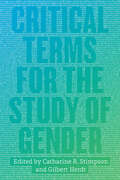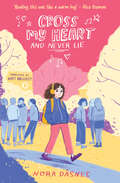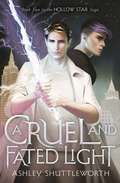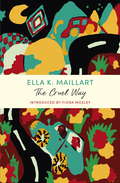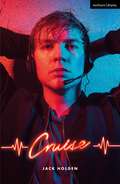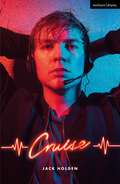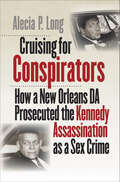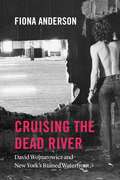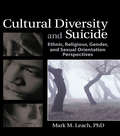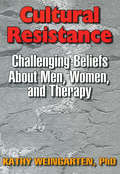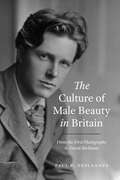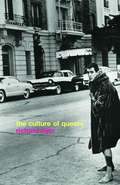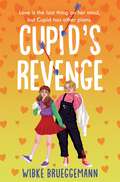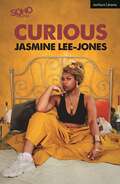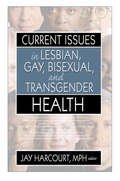- Table View
- List View
Critical Terms for the Study of Gender (Critical Terms)
“Gender systems pervade and regulate human lives—in law courts and operating rooms, ballparks and poker clubs, hair-dressing salons and kitchens, classrooms and playgroups. . . . Exactly how gender works varies from culture to culture, and from historical period to historical period, but gender is very rarely not at work. Nor does gender operate in isolation. It is linked to other social structures and sources of identity.” So write women’s studies pioneer Catharine R. Stimpson and anthropologist Gilbert Herdt in their introduction to Critical Terms for the Study of Gender, laying out the wide-ranging nature of this interdisciplinary and rapidly changing field. The sixth in the series of “Critical Terms” books, this volume provides an indispensable introduction to the study of gender through an exploration of key terms that are a part of everyday discourse in this vital subject. Following Stimpson and Herdt’s careful account of the evolution of gender studies and its relation to women’s and sexuality studies, the twenty-one essays here cast an appropriately broad net, spanning the study of gender and sexuality across the humanities and social sciences. Written by a distinguished group of scholars, each essay presents students with a history of a given term—from bodies to utopia—and explains the conceptual baggage it carries and the kinds of critical work it can be made to do. The contributors offer incisive discussions of topics ranging from desire, identity, justice, and kinship to love, race, and religion that suggest new directions for the understanding of gender studies. The result is an essential reference addressed to students studying gender in very different disciplinary contexts.
Cross My Heart and Never Lie
by Nora DåsnesA gorgeous full-colour coming-of-age novel, perfect for fans of Judy Blume’s Are You There God? It’s Me, Margaret, Katie Kirby’s The Mega Complicated Crushes of Lottie Brooks and The Babysitter’s Club graphic novels
A Cruel and Fated Light (A Dark and Hollow Star)
by Ashley ShuttleworthAn ailing king. An ambitious queen. Four tenuous friends. And a deadly game that threatens them all.The stakes are higher than ever in this thrilling sequel to A Dark and Hollow Star.After thwarting the man behind the gruesome ironborn murders - and breaking several fae laws to do so - all Arlo wants is a quiet summer. As the deity of luck's Hollow Star, capable of bringing about endless possibilities, this shouldn't be too much to ask, right?But someone is still trying to summon the mythical Seven Deadly Sins. All signs point to immortal meddling, and if this is the gods' attempt at returning to the Mortal Realm, it's Arlo they're going to use to do it.When Queen Riadne offers to host Arlo at the Seelie Summer palace, she jumps at the chance. She'll get to see more of Vehan and Aurelian and perhaps even work out her complicated feelings for the gorgeous ex-Fury, Nausicaä. But no one trusts the infamous Queen of Light, even as Arlo wonders if she's just been greatly misunderstood.With the Summer Solstice quickly approaching, everyone expects Riadne to finally challenge the High King for his crown. And as Arlo struggles to get control of her powers and take charge of her destiny, she'll soon be faced with a choice that won't only change the fate of the Mortal Realm forever, but could condemn it to a cruelty the likes of which the Courts have never known.
The Cruel Way: A John Murray Journey (Overcoming Books)
by Ella K MaillartINTRODUCED BY FIONA MOZLEY, Booker-shortlisted author of ElmetWITH EXCERPTS FROM ALL THE ROADS ARE OPEN BY ANNEMARIE SCHWARZENBACH'We were both travellers - she always running away from an emotional crisis (not seeing that she was already wishing for the next), I always seeking far afield the secret of harmonious living, or filling up time by courting risk, caught by the clean sharp "taste" it gives to life.'In 1939, adventurer and writer Ella Maillart set off on an epic drive from Geneva to Kabul, accompanied by journalist and photographer Annemarie Schwarzenbach, who later became an antifascist and lesbian icon. The two women travelled partly to escape the coming war in Europe, embarking on a daring, and often dangerous, journey through regions where European women were a rarity. But Schwarzenbach was also fighting a losing battle with morphine addiction, and the women's close but often troubled relationship takes centre stage in the narrative as the journey progresses through Turkey, Iran and Afghanistan. Encountering breathtaking landscapes, ancient ruins and nomadic peoples, The Cruel Way is a gripping, lyrical and deeply empathetic portrait of places, people and friendship. Brought together for the first time with excerpts from All the Roads are Open, Annemarie Schwarzenbach's parallel account of the journey.
Cruise (Modern Plays)
by Jack HoldenSet in London's Soho in the 1980s, Cruise tells the story of what should have been Michael Spencer's last night on Earth. Diagnosed with HIV in 1984, he's told by doctors that he has just four years to live, so as the clock runs down, Michael decides to go out in style. As he parties and bids final farewells to his friends, the clock strikes zero and Michael… survives. With the gift of life, how can he go on living?Jack Holden's debut play Cruise is a kaleidoscopic new monologue celebrating queer culture and paying tribute to ageneration of gay men lost to the AIDS crisis. This edition was published to coincide with its West End production in May 2021.
Cruise (Modern Plays)
by Jack HoldenSet in London's Soho in the 1980s, Cruise tells the story of what should have been Michael Spencer's last night on Earth. Diagnosed with HIV in 1984, he's told by doctors that he has just four years to live, so as the clock runs down, Michael decides to go out in style. As he parties and bids final farewells to his friends, the clock strikes zero and Michael… survives. With the gift of life, how can he go on living?Jack Holden's debut play Cruise is a kaleidoscopic new monologue celebrating queer culture and paying tribute to ageneration of gay men lost to the AIDS crisis. This edition was published to coincide with its West End production in May 2021.
Cruising for Conspirators: How a New Orleans DA Prosecuted the Kennedy Assassination as a Sex Crime (Boundless South)
by Alecia P. LongNew Orleans district attorney Jim Garrison's decision to arrest Clay Shaw on March 1, 1967, set off a chain of events that culminated in the only prosecution undertaken in the assassination of John F. Kennedy. In the decades since Garrison captured headlines with this high-profile legal spectacle, historians, conspiracy advocates, and Hollywood directors alike have fixated on how a New Orleans–based assassination conspiracy might have worked. Cruising for Conspirators settles the debate for good, conclusively showing that the Shaw prosecution was not based in fact but was a product of the criminal justice system's long-standing preoccupation with homosexuality. Tapping into the public's willingness to take seriously conspiratorial explanations of the Kennedy assassination, Garrison drew on the copious files the New Orleans police had accumulated as they surveilled, harassed, and arrested increasingly large numbers of gay men in the early 1960s. He blended unfounded accusations with homophobia to produce a salacious story of a New Orleans-based scheme to assassinate JFK that would become a national phenomenon. At once a dramatic courtroom narrative and a deeper meditation on the enduring power of homophobia, Cruising for Conspirators shows how the same dynamics that promoted Garrison's unjust prosecution continue to inform conspiratorial thinking to this day.
Cruising the Dead River: David Wojnarowicz and New York's Ruined Waterfront
by Fiona AndersonIn the 1970s, Manhattan’s west side waterfront was a forgotten zone of abandoned warehouses and piers. Though many saw only blight, the derelict neighborhood was alive with queer people forging new intimacies through cruising. Alongside the piers’ sexual and social worlds, artists produced work attesting to the radical transformations taking place in New York. Artist and writer David Wojnarowicz was right in the heart of it, documenting his experiences in journal entries, poems, photographs, films, and large-scale, site-specific projects. In Cruising the Dead River, Fiona Anderson draws on Wojnarowicz’s work to explore the key role the abandoned landscape played in this explosion of queer culture. Anderson examines how the riverfront’s ruined buildings assumed a powerful erotic role and gave the area a distinct identity. By telling the story of the piers as gentrification swept New York and before the AIDS crisis, Anderson unearths the buried histories of violence, regeneration, and LGBTQ activism that developed in and around the cruising scene.
Cruising the Dead River: David Wojnarowicz and New York's Ruined Waterfront
by Fiona AndersonIn the 1970s, Manhattan’s west side waterfront was a forgotten zone of abandoned warehouses and piers. Though many saw only blight, the derelict neighborhood was alive with queer people forging new intimacies through cruising. Alongside the piers’ sexual and social worlds, artists produced work attesting to the radical transformations taking place in New York. Artist and writer David Wojnarowicz was right in the heart of it, documenting his experiences in journal entries, poems, photographs, films, and large-scale, site-specific projects. In Cruising the Dead River, Fiona Anderson draws on Wojnarowicz’s work to explore the key role the abandoned landscape played in this explosion of queer culture. Anderson examines how the riverfront’s ruined buildings assumed a powerful erotic role and gave the area a distinct identity. By telling the story of the piers as gentrification swept New York and before the AIDS crisis, Anderson unearths the buried histories of violence, regeneration, and LGBTQ activism that developed in and around the cruising scene.
Cruising the Dead River: David Wojnarowicz and New York's Ruined Waterfront
by Fiona AndersonIn the 1970s, Manhattan’s west side waterfront was a forgotten zone of abandoned warehouses and piers. Though many saw only blight, the derelict neighborhood was alive with queer people forging new intimacies through cruising. Alongside the piers’ sexual and social worlds, artists produced work attesting to the radical transformations taking place in New York. Artist and writer David Wojnarowicz was right in the heart of it, documenting his experiences in journal entries, poems, photographs, films, and large-scale, site-specific projects. In Cruising the Dead River, Fiona Anderson draws on Wojnarowicz’s work to explore the key role the abandoned landscape played in this explosion of queer culture. Anderson examines how the riverfront’s ruined buildings assumed a powerful erotic role and gave the area a distinct identity. By telling the story of the piers as gentrification swept New York and before the AIDS crisis, Anderson unearths the buried histories of violence, regeneration, and LGBTQ activism that developed in and around the cruising scene.
Cruising the Dead River: David Wojnarowicz and New York's Ruined Waterfront
by Fiona AndersonIn the 1970s, Manhattan’s west side waterfront was a forgotten zone of abandoned warehouses and piers. Though many saw only blight, the derelict neighborhood was alive with queer people forging new intimacies through cruising. Alongside the piers’ sexual and social worlds, artists produced work attesting to the radical transformations taking place in New York. Artist and writer David Wojnarowicz was right in the heart of it, documenting his experiences in journal entries, poems, photographs, films, and large-scale, site-specific projects. In Cruising the Dead River, Fiona Anderson draws on Wojnarowicz’s work to explore the key role the abandoned landscape played in this explosion of queer culture. Anderson examines how the riverfront’s ruined buildings assumed a powerful erotic role and gave the area a distinct identity. By telling the story of the piers as gentrification swept New York and before the AIDS crisis, Anderson unearths the buried histories of violence, regeneration, and LGBTQ activism that developed in and around the cruising scene.
Cruising the Dead River: David Wojnarowicz and New York's Ruined Waterfront
by Fiona AndersonIn the 1970s, Manhattan’s west side waterfront was a forgotten zone of abandoned warehouses and piers. Though many saw only blight, the derelict neighborhood was alive with queer people forging new intimacies through cruising. Alongside the piers’ sexual and social worlds, artists produced work attesting to the radical transformations taking place in New York. Artist and writer David Wojnarowicz was right in the heart of it, documenting his experiences in journal entries, poems, photographs, films, and large-scale, site-specific projects. In Cruising the Dead River, Fiona Anderson draws on Wojnarowicz’s work to explore the key role the abandoned landscape played in this explosion of queer culture. Anderson examines how the riverfront’s ruined buildings assumed a powerful erotic role and gave the area a distinct identity. By telling the story of the piers as gentrification swept New York and before the AIDS crisis, Anderson unearths the buried histories of violence, regeneration, and LGBTQ activism that developed in and around the cruising scene.
Cruising the Dead River: David Wojnarowicz and New York's Ruined Waterfront
by Fiona AndersonIn the 1970s, Manhattan’s west side waterfront was a forgotten zone of abandoned warehouses and piers. Though many saw only blight, the derelict neighborhood was alive with queer people forging new intimacies through cruising. Alongside the piers’ sexual and social worlds, artists produced work attesting to the radical transformations taking place in New York. Artist and writer David Wojnarowicz was right in the heart of it, documenting his experiences in journal entries, poems, photographs, films, and large-scale, site-specific projects. In Cruising the Dead River, Fiona Anderson draws on Wojnarowicz’s work to explore the key role the abandoned landscape played in this explosion of queer culture. Anderson examines how the riverfront’s ruined buildings assumed a powerful erotic role and gave the area a distinct identity. By telling the story of the piers as gentrification swept New York and before the AIDS crisis, Anderson unearths the buried histories of violence, regeneration, and LGBTQ activism that developed in and around the cruising scene.
Cultural Diversity and Suicide: Ethnic, Religious, Gender, and Sexual Orientation Perspectives
by Mark M LeachThis book adds a vital and overlooked dimension-diversity-to suicide assessments and interventions The literature on the relationship between culture and suicide has historically been widely scattered and often difficult to find. Cultural Diversity and Suicide summarizes that widespread literature so that counselors can begin to include diversity issues as important variables that can help them become even more effective when conducting suicide assessments or interventions. For ease of reading, Cultural Diversity and Suicide is divided into chapters based on ethnicity. The book avoids broad generalizations whenever possible, thus each chapter specifically discusses critical within-group variables (issues relating to gender, age, religion, and sexuality) that should be considered when conducting suicide assessments and interventions. Each chapter includes at least one case study and incorporates clear headings that make it simple to find specific information.Cultural Diversity and Suicide is not a book of cookie-cutter approaches to suicide prevention, nor is it a primer for the novice. Rather, it has been carefully designed to help counselors and counselors-in-training gain a fuller understanding of the issues that may lead individuals from diverse backgrounds to consider suicide-and the cultural aspects of an individual&’s heritage that can influence that person&’s decision. Written for professionals who have a pre-existing understanding of how to work with suicidal clients, the book begins with a concise but essential overview of traditional suicide risk factors and a brief assessment model (an excellent "memory refresher"), and then moves quickly into specific diversity issues relevant to: European Americans African Americans Asian Americans Hispanic Americans Native AmericansCultural Diversity and Suicide explores ethnicity and its relationship to suicide (for example, suicide rate and reason differences based on ethnic group or ethnic identity), plus meaningful within-group variables such as: lesbian/gay/bisexual issues and the increase in suicide rate based on sexual orientation and sexual identity religious differences-suicide rates among various religious groups, religious differences in views of suicide, views of the afterlife, burial practices, and views of lesbian/gay/bisexual people cultural buffers, such as extended family and religious practice suicide prevention interventions based on cultural differences (essentially, how traditional suicide prevention programs can be altered to include new variables)This book is essential reading for everyone doing the vital work of conducting suicide assessments and interventions. Please consider making it part of your professional/teaching collection today.
Cultural Diversity and Suicide: Ethnic, Religious, Gender, and Sexual Orientation Perspectives
by Mark M LeachThis book adds a vital and overlooked dimension-diversity-to suicide assessments and interventions The literature on the relationship between culture and suicide has historically been widely scattered and often difficult to find. Cultural Diversity and Suicide summarizes that widespread literature so that counselors can begin to include diversity issues as important variables that can help them become even more effective when conducting suicide assessments or interventions. For ease of reading, Cultural Diversity and Suicide is divided into chapters based on ethnicity. The book avoids broad generalizations whenever possible, thus each chapter specifically discusses critical within-group variables (issues relating to gender, age, religion, and sexuality) that should be considered when conducting suicide assessments and interventions. Each chapter includes at least one case study and incorporates clear headings that make it simple to find specific information.Cultural Diversity and Suicide is not a book of cookie-cutter approaches to suicide prevention, nor is it a primer for the novice. Rather, it has been carefully designed to help counselors and counselors-in-training gain a fuller understanding of the issues that may lead individuals from diverse backgrounds to consider suicide-and the cultural aspects of an individual&’s heritage that can influence that person&’s decision. Written for professionals who have a pre-existing understanding of how to work with suicidal clients, the book begins with a concise but essential overview of traditional suicide risk factors and a brief assessment model (an excellent "memory refresher"), and then moves quickly into specific diversity issues relevant to: European Americans African Americans Asian Americans Hispanic Americans Native AmericansCultural Diversity and Suicide explores ethnicity and its relationship to suicide (for example, suicide rate and reason differences based on ethnic group or ethnic identity), plus meaningful within-group variables such as: lesbian/gay/bisexual issues and the increase in suicide rate based on sexual orientation and sexual identity religious differences-suicide rates among various religious groups, religious differences in views of suicide, views of the afterlife, burial practices, and views of lesbian/gay/bisexual people cultural buffers, such as extended family and religious practice suicide prevention interventions based on cultural differences (essentially, how traditional suicide prevention programs can be altered to include new variables)This book is essential reading for everyone doing the vital work of conducting suicide assessments and interventions. Please consider making it part of your professional/teaching collection today.
Cultural Resistance: Challenging Beliefs About Men, Women, and Therapy
by Kaethe WeingartenIn everyday life--in relationships, in various institutions, in texts--cultural premises influence and sometimes limit individuals’thoughts, actions, and ideas. Cultural Resistance: Challenging Beliefs About Men, Women, and Therapy analyzes cultural constraints and encourages therapists, individuals, and communities to practice cultural resistance on a daily basis, allowing for the realization of diverse and suppressed knowledges. Cultural Resistance shows general patterns by which some ideas in a culture become accepted and others are marginalized. It proposes ways individuals and communities can resist the hold of limiting ideas on their lives. In the postmodern tradition, Editor Kathy Weingarten brings together authors who ask and offer answers to the question, “What is not present in our thinking?” Each chapter invites therapists to extend their thinking about the scope of their work. Topics covered include: challenging cultural beliefs about mothers transforming masculine identities lesbian and gay parents a narrative approach to anorexia/bulimia perspectives on the Black woman and sexual trauma, focusing on Thomas v. Hill opening therapy to conversations with a personal god new conversations on controversial issuesThe chapters in Cultural Resistance first describe cultural premises that constrain the lives of women, men, and/or therapists and then develop an approach to resisting these constraints. A response follows each chapter in an effort to promote discourse, extend meanings, and encourage learning between professionals.Cultural Resistance yields new perspectives on the nature of social change and the relationships between individuals and culture. It offers valuable insights to family therapists, psychiatrists, psychologists, and social workers who want to broaden their thinking and approach. It gives therapists a fresh, new way of thinking about themselves, others, and their conversations through applications which may be professional, personal, or both.
Cultural Resistance: Challenging Beliefs About Men, Women, and Therapy
by Kaethe WeingartenIn everyday life--in relationships, in various institutions, in texts--cultural premises influence and sometimes limit individuals’thoughts, actions, and ideas. Cultural Resistance: Challenging Beliefs About Men, Women, and Therapy analyzes cultural constraints and encourages therapists, individuals, and communities to practice cultural resistance on a daily basis, allowing for the realization of diverse and suppressed knowledges. Cultural Resistance shows general patterns by which some ideas in a culture become accepted and others are marginalized. It proposes ways individuals and communities can resist the hold of limiting ideas on their lives. In the postmodern tradition, Editor Kathy Weingarten brings together authors who ask and offer answers to the question, “What is not present in our thinking?” Each chapter invites therapists to extend their thinking about the scope of their work. Topics covered include: challenging cultural beliefs about mothers transforming masculine identities lesbian and gay parents a narrative approach to anorexia/bulimia perspectives on the Black woman and sexual trauma, focusing on Thomas v. Hill opening therapy to conversations with a personal god new conversations on controversial issuesThe chapters in Cultural Resistance first describe cultural premises that constrain the lives of women, men, and/or therapists and then develop an approach to resisting these constraints. A response follows each chapter in an effort to promote discourse, extend meanings, and encourage learning between professionals.Cultural Resistance yields new perspectives on the nature of social change and the relationships between individuals and culture. It offers valuable insights to family therapists, psychiatrists, psychologists, and social workers who want to broaden their thinking and approach. It gives therapists a fresh, new way of thinking about themselves, others, and their conversations through applications which may be professional, personal, or both.
The Culture of Male Beauty in Britain: From the First Photographs to David Beckham
by Paul R. DeslandesA heavily illustrated history of two centuries of male beauty in British culture. Spanning the decades from the rise of photography to the age of the selfie, this book traces the complex visual and consumer cultures that shaped masculine beauty in Britain, examining the realms of advertising, health, pornography, psychology, sport, and celebrity culture. Paul R. Deslandes chronicles the shifting standards of male beauty in British culture—from the rising cult of the athlete to changing views on hairlessness—while connecting discussions of youth, fitness, and beauty to growing concerns about race, empire, and degeneracy. From earlier beauty show contestants and youth-obsessed artists, the book moves through the decades into considerations of disfigured soldiers, physique models, body-conscious gay men, and celebrities such as David Beckham and David Gandy who populate the worlds of television and social media. Deslandes calls on historians to take beauty and gendered aesthetics seriously while recasting how we think about the place of physical appearance in historical study, the intersection of different forms of high and popular culture, and what has been at stake for men in “looking good.”
The Culture of Queers
by Richard DyerFor around a hundred years up to the Stonewall riots, the word used for gay men was 'queers'. In The Culture of Queers, Richard Dyer traces the contours of queer culture, examining the differences and continuities with the gay culture which succeeded it. Opening with a discussion of the very concept of 'queers', Dyer asks what it means to speak of a sexual grouping having a culture, and addresses issues such as gay attitudes to women and the notion of camp. From screaming queens to sensitive vampires and sad young men, and from pulp novels to pornography to the films of Fassbinder, The Culture of Queers explores the history of queer arts and media.
The Culture of Queers
by Richard DyerFor around a hundred years up to the Stonewall riots, the word used for gay men was 'queers'. In The Culture of Queers, Richard Dyer traces the contours of queer culture, examining the differences and continuities with the gay culture which succeeded it. Opening with a discussion of the very concept of 'queers', Dyer asks what it means to speak of a sexual grouping having a culture, and addresses issues such as gay attitudes to women and the notion of camp. From screaming queens to sensitive vampires and sad young men, and from pulp novels to pornography to the films of Fassbinder, The Culture of Queers explores the history of queer arts and media.
Cupid's Revenge (Phoebe Davis Thinks . . . #2)
by Wibke BrueggemannFor the record, it was never my intention to fall in love. But you know Cupid: he'll get you when you least expect it . . .Tilly isn't looking for a girlfriend, but her best friend Teddy is.Enter Katherine Cooper-Bunting: beautiful, charming, and perfect for Teddy. So why does Tilly find herself using any excuse to join the theatre production they're starring in?And why can't she stop thinking about Katherine?Cupid's Revenge by Wibke Brueggemann is a hilariously honest novel full of heart, from the acclaimed author of Love is for Losers.
curious (Modern Plays)
by Jasmine Lee-JonesBeing a woman is blood and gutsIt's intestineFuck florals and ballgownsIt's ballsIt's livers and kidneys and puke and mucusRipping and tearing and shreddingRed stain on linen beddingIt's sheddingJaz is in her second year at drama school. Jaz is tired of performing. Hence her conundrum. But when she stumbles across a piece of forgotten history – her life is changed forever…What does it mean to find yourself? Especially when it seems the world you live in is diametrically set against you doing just that?Set against the sprawling backdrop of urban London across centuries, curious is a frank, funny and moving excavation of the lives of two actresses who are young, Black, queer and trying to find out who they are. It is written and performed by Jasmine Lee-Jones, the winner of Evening Standard Award 2019 and Critics' Circle Theatre Award for Most Promising Playwright for her play seven methods of killing kylie jenner.
curious (Modern Plays)
by Jasmine Lee-JonesBeing a woman is blood and gutsIt's intestineFuck florals and ballgownsIt's ballsIt's livers and kidneys and puke and mucusRipping and tearing and shreddingRed stain on linen beddingIt's sheddingJaz is in her second year at drama school. Jaz is tired of performing. Hence her conundrum. But when she stumbles across a piece of forgotten history – her life is changed forever…What does it mean to find yourself? Especially when it seems the world you live in is diametrically set against you doing just that?Set against the sprawling backdrop of urban London across centuries, curious is a frank, funny and moving excavation of the lives of two actresses who are young, Black, queer and trying to find out who they are. It is written and performed by Jasmine Lee-Jones, the winner of Evening Standard Award 2019 and Critics' Circle Theatre Award for Most Promising Playwright for her play seven methods of killing kylie jenner.
Current Issues in Lesbian, Gay, Bisexual, and Transgender Health
by Jay HarcourtLearn what resources are needed for lesser-recognized LGBT health issuesMost literature that explores LGBT health issues concentrates on HIV/AIDS while leaving research studies on other vital issues lacking. Current Issues in Lesbian, Gay, Bisexual, and Transgender Health addresses this inadequacy by presenting a broad range of LGBT health issues from an interdisciplinary and mixed-method perspective. Leading experts present both quantitative and qualitative descriptions of health issues among various population groups, focusing on those topics poorly represented in present-day literature. This book is a strong start to fill in the blanks about unrealized health issues of LGBT individuals and offers insights into the resources needed to address them.Methods to assess sexual orientation and gender identity are not normally found in most population-based research. Because of the diversity within the relatively small LGBT population, research has been forced to generalize, making it less likely to effectively contribute to quality health issue data for these individuals. The research presented in Current Issues in Lesbian, Gay, Bisexual, and Transgender Health takes particular care to specify how the orientation and sexual identity of study participants was measured. This book carefully mines previously unrevealed health disparities among LGBT populations across a broad spectrum of diseases-beyond the standard focus on HIV/AIDS. The most current and important studies are presented, including rare research on transgender health issues. The chapters are extensively referenced, and several include figures and tables to clarify and enhance understanding of the information.The wide range of topics in Current Issues in Lesbian, Gay, Bisexual, and Transgender Health include: the inclusion of sexual orientation questions in research studies comparison of mental health issues between women of different sexual orientations mental health issues among men of different sexual orientations and HIV status in Australia the impact of sexual identity distress and social support in GLBT youth issues transgender youth health issues female-to-male (FTM) transexuals&’ experiences accessing health care research on LBT domestic violence survivors health needs of male-to-female (MTF) transgenders of colorCurrent Issues in Lesbian, Gay, Bisexual, and Transgender Health is crucial, thought-provoking reading for researchers working in LGBT health, public health professionals working in community health and LGBT health, policymakers, advocates, public health and community health faculty, and students interested in LGBT health issues.
Current Issues in Lesbian, Gay, Bisexual, and Transgender Health
by Jay Harcourt MphLearn what resources are needed for lesser-recognized LGBT health issuesMost literature that explores LGBT health issues concentrates on HIV/AIDS while leaving research studies on other vital issues lacking. Current Issues in Lesbian, Gay, Bisexual, and Transgender Health addresses this inadequacy by presenting a broad range of LGBT health issues from an interdisciplinary and mixed-method perspective. Leading experts present both quantitative and qualitative descriptions of health issues among various population groups, focusing on those topics poorly represented in present-day literature. This book is a strong start to fill in the blanks about unrealized health issues of LGBT individuals and offers insights into the resources needed to address them.Methods to assess sexual orientation and gender identity are not normally found in most population-based research. Because of the diversity within the relatively small LGBT population, research has been forced to generalize, making it less likely to effectively contribute to quality health issue data for these individuals. The research presented in Current Issues in Lesbian, Gay, Bisexual, and Transgender Health takes particular care to specify how the orientation and sexual identity of study participants was measured. This book carefully mines previously unrevealed health disparities among LGBT populations across a broad spectrum of diseases-beyond the standard focus on HIV/AIDS. The most current and important studies are presented, including rare research on transgender health issues. The chapters are extensively referenced, and several include figures and tables to clarify and enhance understanding of the information.The wide range of topics in Current Issues in Lesbian, Gay, Bisexual, and Transgender Health include: the inclusion of sexual orientation questions in research studies comparison of mental health issues between women of different sexual orientations mental health issues among men of different sexual orientations and HIV status in Australia the impact of sexual identity distress and social support in GLBT youth issues transgender youth health issues female-to-male (FTM) transexuals&’ experiences accessing health care research on LBT domestic violence survivors health needs of male-to-female (MTF) transgenders of colorCurrent Issues in Lesbian, Gay, Bisexual, and Transgender Health is crucial, thought-provoking reading for researchers working in LGBT health, public health professionals working in community health and LGBT health, policymakers, advocates, public health and community health faculty, and students interested in LGBT health issues.
